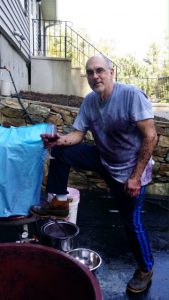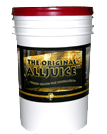Red Hot Chicken Mini Pizzas & Riesling
Red Hot Chicken Mini Pizzas & Riesling
Heat things up with these Red Hot Chicken Mini Pizzas!
Whether you’re munching on it while binge watching your favorite TV show, or serving at your next party – it’s perfect for virtually any time and place!
Ingredients:
2 tablespoons Frank’s original red hot sauce
2 8” pre-made pizza crusts
¼ lb Colby jack cheese (shredded or sliced)
2 tomatoes, diced
½ red onion, diced
¼ lb rotisserie chicken (pulled apart and marinated in Frank’s hot sauce)
Blue cheese salad dressing
Celery and carrot sticks
Instructions:
- Heat oven to 425 degrees
- Spread 1 table spoon of Frank’s hot sauce over each crust, leaving ½ for the edge.
- Top with chicken, tomatoes, onion and cheese.
- Place pizzas directly on an oven rack. Bake 8-10 minutes.
- Cheese should be melted and crust should be golden brown.
- Slice and serve, alongside blue cheese dressing and celery sticks.
Don’t forget the Riesling! The combination of sweet and acidic is what makes Riesling a great match for spicier foods, taming the intense heat with a honeyed splash.
Sauvignon Blanc Paired with Mexican 7 Layer Dip Recipe
Who doesn’t love a good Sauvignon Blanc? Whether it’s from California, France, Chile, South Africa, or New Zealand you can always count on it being fresh and crisp. The perfect pairing with Ashley’s favorite 7 layer bean dip recipe. It’s the ultimate combination of Mexican flavors including refried beans, guacamole, sour cream, cheese, tomatoes, green onions and black olives. It’s super easy to make and can be made ahead of time, stored in the refrigerator and served cold or at room temperature.
What you’ll need:
- Refried beans
- Taco seasoning
- Guacamole
- Sour cream
- Shredded cheddar cheese
- Tomatoes
- Black olives
- Green onions
- Lime
- Salt & Pepper
How to do it:
- In a bowl, mix the refried beans and taco seasoning together.
- Spread the refried beans onto a casserole dish.
- On top of the bean spread, add your layer of guacamole. Add some salt & pepper and squeeze a lime over to get the extra flavor packed in.
- Add a layer of sour cream.
- Add a layer of diced tomatoes.
- Add a layer of sour cream.
- Top with your sliced olives and green onions.
- If you’d like the extra kick, add some chopped jalapeños.
- Cover and pop in the fridge! Easy peasy.
- When it comes to serving, it can be served chilled or at room temperature with a bowl of tortilla corn chips.
As always, adding wine make everything 10 times better – A gutsy, grassy white wine like Sauvignon Blanc will go with the crunchy corn tortillas, while the melted cheddar cheese will harmonize with an easy going wine like Grenache.
Valentine’s Day Wine Infused Strawberries
A delightful treat for you and your sweet heart on Valentine’s Day
What you’ll need:
– One Container of Strawberries (16 oz)
– One cup of white chocolate chips
– One cup of strawberry Moscato
– Pipette tubes
How it’s made:
– Start by melting your white chocolate chips. You can do this by boiling water in a double boiling pot. You only need about 1 inch of water, giving some space between the water and the top half of the boiler. If you do not have a double boiler, try using any pot and metal bowl combo that fit together securely. Once the water is boiling, reduce the heat to low, and add your chocolate chips to the top bowl.
– Remove the melted white chocolate from the heat after a majority of it has melted. If there are still clumps, no worries, the chocolate will continue to melt as you stir it around. Stir until smooth.
- (Optional) Add a few drops of red food coloring to bring your white chocolate to a sweet pink or a romantic red! Next, dip the strawberry ends into the melted white chocolate and twist the strawberry around to get all sides covered.
- (Optional) Before the white chocolate hardens on the strawberries, quickly roll through some heart-shaped sprinkles. How cute!
– Now for the fun part – fill the pipettes with your strawberry Moscato, insert into the strawberries and enjoy!
Like Moscato?
Check out Shirley’s White Chocolate Chip Cookie and Moscato recipe and paring.
Want to make your own Moscato d’Asti? Musto Wine Grape Company is New England’s largest supplier for home winemaking products and services. We’ll get you set up with all of your juice, grape and equipment needs and have you on track to making your own perfect pairing. Visit juicegrape.com or give us a call at (877) 812 – 1137 to learn more. We look forward to hearing from you!
Cabernet Chocolate Cake Recipe
National Chocolate Cake Day is on January 27th!
Celebrate by trying our dark chocolate red wine cake recipe. This decadent cake, smothered in sweet red wine raspberry sauce is sure to please your pallet.
What you’ll need for the cake:
- 2 cups of sugar
- 1 ¾ cups of all purpose flour
- ¾ cup of dark cocoa powder
- 2 teaspoons of baking soda
- 1 teaspoon of baking powder
- 1 teaspoon of salt
- 2 eggs
- 1 cup of buttermilk
- 1 cup of cabernet sauvignon
- ½ cup of light olive oil
- 2 tea spoons of pure vanilla extract
What you’ll need for the glaze:
- 2 cups of heavy cream
- 1 cup of Cabernet Sauvignon
- 1 ½ cups of bittersweet cocoa powder, preferably 60% cocoa
- 3 tablespoons of corn syrup
- ½ cup of granulated sugar
- 1/8 teaspoon of salt
- 4 tablespoons of softened butter
What you’ll need for the red wine raspberry sauce:
- 2 containers of fresh raspberries
- ¾ – 1 cup of sugar
- 2 table spoons of cabernet sauvignon
Baking Instructions:
Sift all dry ingredients and mix together into one bowl.
Add wet ingredients to dry ingredients and mix well.
Pour batter into two round cake pans.
Bake at 350 for about 28 minutes, check with tooth pick inserted into the center. If it comes out clean, you’re good to go! Remove the cake from the oven and allow to cool.
Glaze Instructions:
In a pan over medium heat, add the chocolate and cream and stir until combined.
Add the corn syrup and mix until combined.
Remove from heat.
The consistency should thicken as it cools, making it easier to spread around the cake.
Sauce Instructions:
Combine the raspberries and sugar in a small saucepan, mashing the raspberries.
Bring to a boil then turn down to a simmer.
Simmer for about 3 minutes and then add in your Cabernet Sauvignon. Continue to simmer for 1 minute.
Remove and let cool.
Once all parts are cooled, spread glaze around. Spread the raspberry sauce, between the two layers of cake. Pour more raspberry sauce over the cake if desired and Enjoy!
Cellar Upgrades: Noblesse
Here is a great product you can use to help fix your wine..
Ever have a wine that’s high in alcohol?
That has a sharp tinge to the mouthfeel?
Then Noblesse is something you want to have in your cellar.
Noblesse is a natural nutrient that is used to help soften wines. Sometimes our grapes are high in brix an we can’t help but have a high alcohol wine. A by product of this is have a “burn” or “hot” sensation at the end of the palate. Or our wines are tasting a little too “sharp” for our liking.
Adding a dose of Noblesse will help soften your wine’s mouthfeel giving the perception of a rounder, silky mouthfeel, while reducing any sulfur smells and any burning sensation from high alcohol wines. Noblesse also helps aid in malolactic fermentation, so you can use this even if your wine is still going through malo.
We hope you consider adding Noblesse to you winemaker’s toolbox!
Hope to see you soon!
www.juicegrape.com – 877.812.1137 – sales@juicegrape.com
The Importance of Pruning Your Home Vineyard
After a holiday respite, when the thermostat plunges downward, comes every grape growers’ favorite task: winter pruning of the vines. This arduous process is integral to the health of the grapevine and its next vintage.
When:
- In late winter to early spring (February-April). In this dormant period, the sap and water runs down from the cordons of the plant into the trunk and roots, allowing the plant to winterize. This cold hardiness will improve over time and the life of the plant. Once the plant has endured the freezing temperatures of the winter, it will be ready to prune.
Why:
- Any grower who has attempted to work with grapes, knows that they are incredibly hardy and vigorous plants. Without aggressive winter pruning, removing approximately 90% of the previous years’ growth, the grapevines will continue to grow vigorously and become and entangled mess upon the trellis. All of the added weight can break the trellis and will generate too much foliage to allow the grapes to receive proper sunlight. The extra foliage can also allow diseases to carry over from the prior growing year, giving them an early head start as soon as temperatures rise.
How:
- There are two main methods of grapevine pruning: cane pruning and spur pruning. In cane pruning, the grower will select the two or four most inner canes closest to the trunk and keep those as renewal canes and remove all of the other growth. On some hybrid or native plants, you could be removing some canes that run 15 feet long! You can’t kill a grapevine, so no need to worry about the large amount of plant material you are removing. It should be about 80-90% of the growth from the former year.
Spur pruning is another style of winter pruning in which the grower will remove the most of the cane growth from the previous year, leaving the main cordons and a 1-2 bud spur behind. The spurs contain 1-2 buds that will produce the following years fruiting canes. As the vine ages, it is important to monitor the cordons for disease and ensure that you are keeping healthy material. The grower can always change over from one method of pruning to another, depending on their grapevines’ individual needs.
An interesting experiment would be to prune two grapevines of the same variety using each different method, and see the results in that years’ harvest!
Interested in making your own wine? Musto Wine Grape Company is here to help! We are New England’s largest supplier for home winemaking products and services. We can get you set up with all of your juice, grape and equipment needs and have you on track to making your own perfect pairing for next fall! Visit juicegrape.com or give us a call at (877) 812 – 1137 to learn more. We look forward to hearing from you!
How to Make Wine in between Grape Harvests
So, it’s winter, my wine is settled in from the fall and I’m bored….
I know winemaking is a year long event, between racking, oaking, sulfiting, filtering, and bottling. But I just love the smell of Fermentation. The nutrient additions, the pressing, and the creation of another vintage for my wine cellar.
I know my wife will call me crazy, but I need to make more wine. But the fall winemaking season is over, right? Wrong! There are options to make wine all year round.
You could wait until April and get grapes and juice from South Africa. I have made the Cabernet and the Pinotage from grapes and both came out great. Believe it or not, the grapes came in clean and gorgeous.
You can wait until May and get a large selection from South America. I make the Malbec or Carmenere every year. They are Chile’s signature wines and they come out wonderful.
There is also an option of buying frozen must. These are grapes that Musto crushed and destemmed. The must is placed in 5.25 gallon pails and frozen. You take the 5.25 gallon pails home, let them thaw out and treat it like your usual must. The benefit of the frozen must is you get a free “cold soak” which creates a dark, full bodied wine. You can also purchase frozen white juice which is just as easy.
My final recommendation is the good old wine kit. Many new winemakers start off with kits, which is a good way to get introduced to this hobby. There are so many choices from all around the world. Even as a “grape” person, don’t be ashamed to make a kit. It rounds out your skills and allows you to make a Riesling from Germany – you can’t get those grapes in the fall!
Well, I hope I gave you some options to keep you busy during the winter “quiet” time for your fall wines. The more wine you make, the better you get. Trying these options will hone your skills and allow you to make other types and styles of wines for your wine cellar. So keep your wine making equipment out and enjoy your hobby all year long!
Written by Frank Renaldi, Musto Wine Grape Bootcamp & Winemaking Professor
Interested in making your own wine? Musto Wine Grape Company is here to help! We are New England’s largest supplier for home winemaking products and services. We can get you set up with all of your juice, grape and equipment needs and have you on track to making your own perfect pairing for next fall! Visit juicegrape.com or give us a call at (877) 812 – 1137 to learn more. We look forward to hearing from you!
Amatuer Winemaking Competition – Awards Dinner will be held on May 30th, 2020
JOIN US IN CELEBRATING YOUR WINES ON
MAY 30th, 2020
AT ZANDRI’S STILLWOOD INN!
Best in show to be announced at the dinner. Celebrate your achievements with your friends, family, our growers, and the Musto crush crew! Grab your tickets HERE.
THE RESULTS & JUDGING NOTES WILL BE RELEASED at the dinner
Location:
- Zandri’s stillwood inn:
- 1074 S. Colony Rd, Wallingford, CT 06492
- May 30th, 2020
- 6:30PM – Midnight
RAFFLE ITEMS:
- Wine Grape Raffles: Wine Grapes & Juices
- Equipment Raffles: Tanks, Barrels, Bottles, Classes, and more!
- Gift Certificate Raffles: You will have multiple opportunities to win gift certificates to Musto Wine Grape
* We are accepting requests to reserve tables. If you would like to reserve a table please include a list of names of the people in your party. Each table holds 8-10 people. If you purchase a grouping of tickets, please email Christina the names of the people you purchased the tickets for.
We will be donating all of the proceeds from the event to Dana Farber Cancer Association to help fight cancer. Please bring cash to purchase your raffle tickets. There is not ATM on site and we do not take credit cards for raffle tickets.
Get excited for a fun night of celebrating, wine tasting, raffle prizes, and dancing!
Where to Stay:
- Homewood Suites by Hilton Wallingford-Meriden
- 90 Miles Dr., Wallingford, CT
- 7 minute drive from venue
- Hilton Garden Inn Wallingford/Meriden
- 1181 Barnes Road, Wallingford, CT
- 8 minute drive from venue
- Courtyard by Marriott New Haven Wallingford
- 600 Northrop Road, Wallingford, CT
- 7 minute drive from venue
*Please note we suggest either having a designated driver or ubering to the event.
Please RSVP/purchase your ticket by May 22nd. Space is limited, so don’t delay! We look forward to seeing you at the Winemaker Dinner!
Top 7 Do’s and Don’ts for Winemaking in Your Home Winery
Let’s face it. There are A LOT of things that can go wrong during the winemaking process. Here are 7 tips for your home winery to help ensure your wine is as tasty as ever.
-
Don’t use bleach!
- While bleach is a great way to clean your bathroom, it is very hazardous to your winery.
- Chlorine bleach is toxic to humans and should never be used to clean any vessels that are used for food purposes.
- Bleach molecules also are prone to lodging themselves in cellulose material. They quickly attach to wood, cardboard, and cork, even through airborne transmission. This is the cause of cork taint, an irreparable wine fault. When the corks have been contaminated with chlorine bleach, they will contaminate the wine they come in contact with, causing a musty, stale aroma.
-
Do a weekly check of airlocks, tank seals, and barrel bungs.
- Accidents happen, and sadly, many accidents can be avoided. Make a good habit of doing a weekly walk through of your home winery.
- Check that your airlocks have the appropriate amount of water.
- Check the gaskets on any tank lids are inflated and on correctly.
- Check that barrel bungs are securely in place and barrels are completely filled up. These small steps can prevent oxidation before it starts.
-
Do rinse off soda ash and B-Brite, Don’t wash off sulfite solution or 1-Step sanitizer.
- Soda Ash and B-Brite are excellent cleaners in the winery. They can help remove the toughest wine stains and wine debris from tanks and carboys.
- They should always be treated like soap and be rinsed off thoroughly.
- A wise additional step is to neutralize any remaining soap with a citric acid rinse. Sulfite solution or 1-step sanitizer can then be applied to sanitize any vessels or equipment. This should not be rinsed off but the equipment should be allowed to drain or remove any bulk remaining pools of sanitizer.
-
Do add sulfites when you rack (every 8 weeks).
- As wine ages, sediment will fall out in precipitate.
- Wine should be siphoned off of the precipitate every few months to maintain clarity and “cleanliness”.
- This is an ideal time to add sulfites. Add 1/4tsp of sulfite powder per 5 gallons of wine. Sulfite powder should always be dissolved in warm water before being stirred into the wine.
-
Don’t reuse store bought bottles.
- While it may seem like a very cost effective step, reusing old bottles can lead to many problems further down the road.
- Never try to put a cork on a screw top bottle! The glass is thinner where the threads are and when trying to remove the cork using a wine opener, the glass is highly prone to cracking.
- All bottles are made differently and can have different diameter necks. It is very important to have the same size corks and bottles to prevent leaks later on. Conversely, if the corks are too large for the bottle, it will be very hard to insert them and this can damage the cork.
-
Don’t soak or boil the corks!
- Soaking or boiling the corks prior to inserting them will actually degrade their quality.
- They will absorb too much liquid and can become brittle or leach the liquid into the bottled wine.
- Instead, lightly mist the corks with sulfite spray prior to bottling.
- Always keep leftover corks in a sealed container.
-
Do Mop up Spills!
- Spills are inevitable in a winery. Be careful to mop up any spills that occur and clean well with a non-bleach cleaner.
- Wipe the exterior of carboys and tanks to be sure there isn’t any wine residue.
- Wipe lids of tanks often if there is any leaking from the airlock or seal.
- If wine spills or leaks are left to sit, it can easily turn acetic, which is an easy source of contamination to the wine. Fruit flies can land on the spill and transfer acetic bacteria into your wine if they happen to land in it.




























Recent Comments